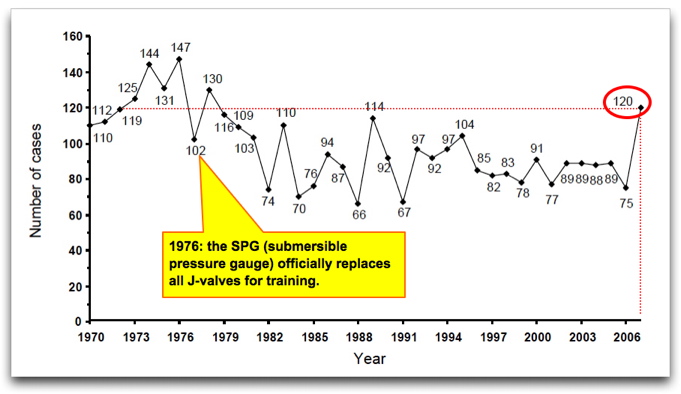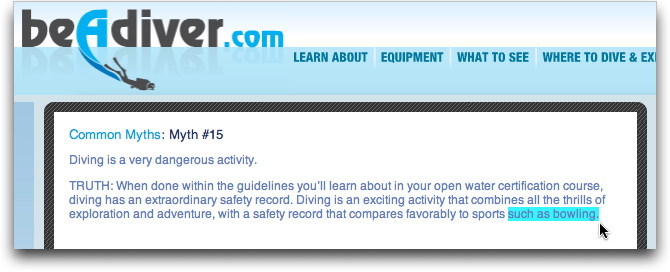This thread started with the proffering of the notion that has been an increase in diver fatalities lately. Do we know this to be true? Is it perception or a statistical fact?
Observational bias? Where do you get your data? Are you biased by relying upon sources with blind faith? Pillars of the community can have feet of clay. Lies, damn lies, and statistics show dive fatalities up 60%No, no "evidence" was presented to support this opinion. The assumption simply is not true. There is no "rise" or "more" deaths in scuba currently. It is observation bias....
Extra credit questionsSome data shows that newer divers are at MUCH greater risk vs. older divers who have better learned how to avoid mishap. If green dive pros are encouraged to trivialize the factual hazards of diving, that could increase mishaps for their students.
Arguably, the only legitimate way to calculate risk is by "exposure time."
The white-water rafting industry calculates their safety statistics based upon days-on-river (i.e. exposure time) per participant. The ski industry tracks accidents by days-on-mountain. Given the size of the global recreational dive industry - over $1 billion p/y, and the preoccupation with statistical tracking to determine safe decompression algorithms, it's suspicious that dive accident data is so murky.
In response to a triple dive fatality, the Abacus Project attempted to bring clarity to dive risks. For 14 months in British Columbia, the number of dive tank air-fills were tracked vs. local recreational dive accidents. Assuming that nothing in this study was "gamed" (i.e. knowing this first-of-its-kind study might impact liability insurance rates, could participating retailers over-report the number of air-fills? Also, local dive professionals may have increased their vigilance for safety above their norm.)
Results: 2.05 deaths per 100,000 dives.
The three victims were all new divers; two died during training, a third was just certified and died while accompanied by an instructor.
Let's factor each "Abacus" dive as a 1-hour "exposure" to risk. Compare that to occupancy time in automobiles. DOT (Department of Transportation) tracks fatalities-per-million-miles-driven, but they don't know the average speed. To be charitable we'll divide those miles by 60 MPH to net total hours of exposure (of course vehicles average less than 60 MPH).
So...2008 saw 37,260 auto fatalities in 2.926 Trillion miles. Allowing 60 MPH average speed, thats 48.766 Billion hours of moving automobiles. Allowing 1.2 occupants per vehicle, thats 58.52 Billion total vehicle occupant hours = 0.0637 fatalities per 100,000 occupant hours of auto travel. The Abacus results are 32X more fatalities-per-hour-of-exposure vs. automobile occupancy.
A Japanese study mentioned in the Undercurrent newsletter, June 2001, found diving between 39X and 62X deadlier than being in an automobile: (from page 16 / bottom of last page of the PDF)Back in the drivers seat: How often have you heard that diving is: A lot safer than driving down a freeway, right? Japanese researchers decided to find out. Deaths per participant were no measure of safety, they thought. A better measure would be deaths per hour engaged in the activity. In looking at Japanese diverand traffic deaths, they found the diving fatality rate to be 10.6 - 24.4 and 15.3 -19.7 with 95 percent and 50 percent of confidence respectively whereas that of driving was 0.206 - 0.270 and 0.232 - 0.244. This means that recreational diving is 39 and 62 times riskier with 95 percent and 50 percent confidence, respectively, than driving a car.----
Ikeda, T. and Ashida, H., Is Recreational Diving Safe? Division of Environmental Medicine and Division of Biomedical Information Sciences, National Defense Medical College Research Institute, Tokorozawa, Japan.
I believe a lackadaisical attitude for safety increases diver deaths. But opinion isn't data, so make up your own minds. There is provocative data from DAN: while many dive pros claim, "Diving is as safe as bowling," DAN reported a 60% spike in dive deaths in 2007 -- a 30-year peak -- the worst year-to-year % jump in 20-years. From DANs 2008 report, (printed in 2009 RE 2007 deaths, page 8):

The 2007 spike in fatalities coincides with the start of the "Be A Diver" marketing campaign. Coincidence?

To be clear of my agenda... I don't want a Nanny state or a country where kids grow up afraid to take risks. I'm no Chicken Little and have taken plenty of calculated risks in diving and aviation. I started flying hang gliders in 1973 and as a director / cameraman have ~2,000 hours filming from fixed-wing and helicopters - usually flying too low, too fast or in locations too remote to survive the unexpected. I believe in planning for the worst and have had the privilege to work with some of the best pilots and mechanics in the world. I've been consulted after movie aviation tragedies when "experts" cut corners. In basic aviation, students are taught to analyze disasters, so they may better avoid being fodder for future students. Accidents are horrible for the victim's family, and bad for business. Pretending that hazards don't exist to lure customers is simply wrong. A genuine safety record will lure plenty of customers.
OK, who's ready to earn extra credit?
(A) Cite the source data that was used to make the bowling claim.
(B) Characterize the reliability of that source data that was used to make the bowling claim.
(C) What other data-sets were excluded to make the bowling claim.
--------------
Let's put this old game in perspective...

(A) Cite the source data that was used to make the bowling claim: a tiny phone-survey mashed up with reports from a few hospitals
(B) Characterize the reliability of that source data that was used to make the bowling claim: poor
(C) What other data-sets were excluded to make the bowling claim: DAN's and PADI's
Fatalities:
A report from a 2006 Risk management seminar disclosed a dive fatality rate, per one insurance company exec, to be FAR HIGHER than what DAN reports - his statement implies >600 dive fatalities per year. Do Pooh-Bahs at the top of the industrys pyramid coerce DMs and Instructors to KEEP SECRETS for the good of the industry?

I love diving and I love decent, hard-working dive pros. Just about everybody Ive ever read on ScubaBoard I consider on the high side of the bell curve, sharing, at heart, what's in the best interests of newbies. We may disagree on process. Dive pros already make a financial sacrifice for the sport; they should not have to be apologists for those who spout that every single fatality was inevitable.
When Drew Richardson, now PADIs president and COO, published a paper that cited data from the National Safety Council and DAN, which claimed diving's safety record under PADI protocol was comparable to bowling, did anyone actually investigate the nature and reliability of the data sources cited by Drew?
The bowling claim began in 1992, published by DAN in their annual report of dive fatalities that occurred in 1990 (see pages 9-10). But where did DAN get their data to make this comparison to bowling? Apparently, not from training agency or insurance company accident reports. AND NOT FROM DANS OWN DATABASE OF PRIOR INJURIES AND FATALITIES.
DANs numerator (number of victims) and denominator (universe of divers) are from two different data sources, which are both entirely outside the dive industry. In summary:US government CPSC-NEISS data forecast from 1994, Fatalities / DCI:---- 0 / 0;For the numerator (total number of injuries): DAN used NEISS data from the US CPSC. NEISS gets reports from 90 hospital emergency rooms, scattered around the country, to estimate total the injuries that require treatment in Americas 7,500 hospitals (estimate). Divers who require recompression treatments go directly to hyperbaric chamber facilities, usually bypassing any NEISS-participating emergency rooms. Scuba accidents reported to NEISS throughout the 1990s averaged less than 31 per year - too tiny a number from which to accurately forecast.
DAN as reported for 1994 ----------------------------------Fatalities / DCI: 104 / ~1,150).
NEISS is notable for what accident data it does not report: automobile / motorcycle / firearm / food / medical product or drug interactions are all not reported. Instead, NEISS focuses on accidents associated with products that fall under the purview of the CPSC. For instance, I fell down (not caused by a product) is not reported to NEISS. Activities with higher frequency (e.g. cooking, biking and skating) produce vastly bigger datasets, and thus more reliable forecasts [NEISS guidelines]
In 4 out of the 9 years from 2000 to 2008, NEISS could not estimate national scuba accidents, because too few accidents were reported. To query the NEISS system: enter Neiss Product Code #: 1275 for scuba accidents in the FIRST FROM BOX. Run the query again for snorkeling accidents, enter code: 3274
For the denominator (the total number of divers): DAN picked 2.6 million divers, per a survey from the National Sporting Goods Association (NSGA). NSGA queried 20,000 homes, but NSGA has no data from dive retailers and training agencies. How the homes were selected is not known, nor what metric classified a diver (i.e. if someone dove once in the last five years are they included?). The larger the denominator, the safer diving appears to be.
A second source alleging a higher fatality rate:
700-800 dive deaths occur per year, per a published estimate using DAN / UHMS data that is restricted to medical researchers (per phone conversation with Dr. Shepherd). DANs annual accident reports disclose that the published deaths are only those with sufficient data; excluded are cases in litigation. It is believed that if cardiac failure appeared to be the cause of death, cases are not reported or not fully investigated by DAN. Notably, it is not possible to know if water aspiration occurred first, which may have triggered cardiac failure culminating in drowning, according to a world Jerome H. Modell, MD, arguably the single most respected medical professional in the United States regarding drownings.
Regardless of the total number of fatalities, I personally believe it is misleading to use the # of divers as a denominator. It should be the # of dives (i.e. exposure times vs. accidents) as Ive posted here with factual citations from other industries.
Arguably, blind faith in the claim of divings safety might instill a lackadaisical attitude toward safety with some dive professionals, which might actually amplify hazards to cause more dive fatalities. Or, as Voltaire warned: Those who can make you believe absurdities can make you commit atrocities.
Has PADI "Taken the Fifth?"
Definitive statistics about diving accidents simply dont exist. How can that be? During litigation, court records can be obtained, but once cases are sealed those records disappear from the Pacer legal document database. Public records related to a 2004 DSD accident, eventually settled in 2008, reveals that PADI's attorneys claimed Fifth and Fourteenth Amendment protection in pre-trial motions, presumably to keep their accident statistics secret.Isham v. PADI first-complaint (Isham and his student were both severely injured)
Ishams amended-complaint (7/2007) alleges that each year 40 fatalities and 400 serious injuries occur to participants and/or instructors during PADI DSDs (#31-32).
PADIs first Response to Isham (item #49 invokes fifth and fourteenth amendments protection for PADI defendants).
Judge Ezra denied PADIs motion to dismiss joint plaintiff claims of fraudulent concealment and negligent misrepresentation [of hazards] (April 2008); PADI continued their defense until the case settled and was sealed (November 2008, over 4 years after the accident). THIS DOCUMENT IS A MUST-READ
Per DAN:
"Dan is not a primary investigative agency...How many [fatality] cases the [DAN] system misses is unknown."
"Dan is not a primary investigative agency...How many [fatality] cases the [DAN] system misses is unknown."



